Posts Tagged ‘Health’ (12 found)
“A Gentleman’s Agreement”
Women make up just over half of the population in Burma, but have been noticeably absent from nearly four years of peace negotiations to end armed conflict in the country […]
• • •Hidden Strengths, Hidden Struggles: Women’s testimonies from southeast Myanmar
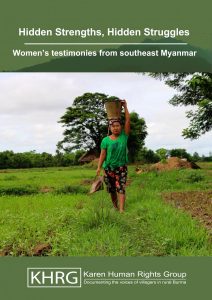 This report presents women’s testimonies in respect of various issues during the reporting period of January 2012 to March 2016. These issues include the dangers posed to women by the presence of armed actors in communities; the effects of land confiscation and development projects on women’s livelihoods; women’s access to healthcare and education; the continued occurrence of gender-based violence; and the harms caused by landmines; forced labour; arbitrary taxation and extortion […]
This report presents women’s testimonies in respect of various issues during the reporting period of January 2012 to March 2016. These issues include the dangers posed to women by the presence of armed actors in communities; the effects of land confiscation and development projects on women’s livelihoods; women’s access to healthcare and education; the continued occurrence of gender-based violence; and the harms caused by landmines; forced labour; arbitrary taxation and extortion […]
Examining Foreign Direct Investment in Mon State, Burma
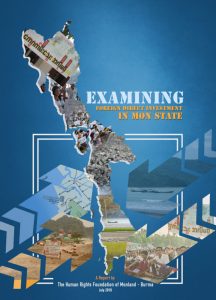 Over the years, the Human Rights Foundation of Monland (HURFOM) has produced a number of accounts highlighting the hardship faced by Mon people who have become victims to land confiscation […]
Over the years, the Human Rights Foundation of Monland (HURFOM) has produced a number of accounts highlighting the hardship faced by Mon people who have become victims to land confiscation […]
Nearly US$100 Billion Flowed Illegally through Myanmar from 1960-2013, Finds New GFI Report
Nearly US$20 billion flowed illegally out of Myanmar between 1960 and 2013— draining domestic resources, driving the underground economy, exacerbating inequality, and facilitating crime and corruption—according to a new report released today by Global Financial Integrity (GFI), a Washington DC-based research and advocacy organization […]
• • •IPPF, through the SPRINT Initiative, Provides Critical Medical and SRH Services to the Flood Affected Population of Sagaing, Myanmar
August 20, 2015: Kuala Lumpur/New Delhi: The International Planned Parenthood Federation (IPPF) is the world’s leading provider of sexual and reproductive health (SRH) services. IPPF, through its humanitarian assistance programme – SPRINT – is providing critical medical and SRH services in the wake of the devastating floods in Sagaing, Myanmar. IPPF East & South East Asia and Oceania Region (IPPF ESEAOR) is responding to the humanitarian crisis through its collaborating partner, the Myanmar Maternal and Child Welfare Association with funding provided by the Australian Department of Foreign Affairs and Trade (DFAT), as part of the Australian Government humanitarian response to the floods […]
• • •Myanmar : Floods Emergency Situation Report (No.4)
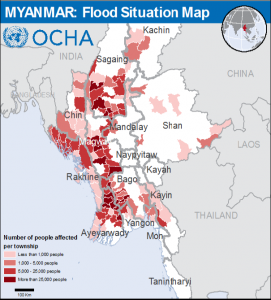 As of 13 August, the NDMC reports that over 1,350,000 people have been severely affected by floods and landslides in July and August. This includes a cumulative number of over 297,000 households that have been or remain temporarily displaced during this period […]
As of 13 August, the NDMC reports that over 1,350,000 people have been severely affected by floods and landslides in July and August. This includes a cumulative number of over 297,000 households that have been or remain temporarily displaced during this period […]
Myanmar: Floods Emergency Situation Report ( No.3)
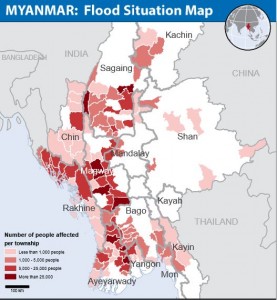 As of 10 August, the National Natural Disaster Management Committee (NDMC) reports that over 1.1 million people have been severely affected by floods and landslides since mid-July. This includes a cumulative number of over 240,000 households that have been or remain temporarily displaced during this period […]
As of 10 August, the National Natural Disaster Management Committee (NDMC) reports that over 1.1 million people have been severely affected by floods and landslides since mid-July. This includes a cumulative number of over 240,000 households that have been or remain temporarily displaced during this period […]
Myanmar: Situation Report No.1 – National Natural Disaster Management Committee
Torrential rain starting from 16 July 2015 in the Northern part of Myanmar and Cyclone Komen that landfall Bengladesh has triggered severe and widespread floods and landslides across twelve states and regions in Myanmar […]
• • •Myanmar: Floods Emergency Situation Report ( No.2)
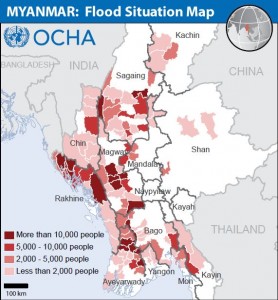 As of 7 August, the Government of Myanmar’s Relief and Resettlement Department (RRD) reports that close to
As of 7 August, the Government of Myanmar’s Relief and Resettlement Department (RRD) reports that close to
590,000 people have been severely affected by monsoonal floods across 12 of Myanmar’s 14 states and regions
since mid-July. This includes a cumulative number of 122,200 households that have been or remain temporarily
displaced during this period. More than 17 million people live in townships that have been inundated by floods in
July and August, according to RRD. At least 96 people are confirmed to have died in the floods since June.
Land and River Grabbing: The Mekong’s Greatest Challenge
07-Land-and-River-Grabbing-2015 sm  Throughout the Mekong region, large-scale development projects such as hydropower dams, mines, conventional power plants, and mono-crop plantations are displacing communities and limiting access to natural resources. Several hydropower dams have already been built on the Upper Mekong in China’s Yunnan Province, and the governments of Cambodia, Laos and Thailand are planning eleven additional large dams on the Mekong River’s mainstream. If completed, these dams would not only destroy local ecosystems, but also reduce the fl ow of silt throughout the Mekong River system, and block major fi sh migrations, placing at risk over sixty million people who depend on the Mekong for their food security and income […]
Throughout the Mekong region, large-scale development projects such as hydropower dams, mines, conventional power plants, and mono-crop plantations are displacing communities and limiting access to natural resources. Several hydropower dams have already been built on the Upper Mekong in China’s Yunnan Province, and the governments of Cambodia, Laos and Thailand are planning eleven additional large dams on the Mekong River’s mainstream. If completed, these dams would not only destroy local ecosystems, but also reduce the fl ow of silt throughout the Mekong River system, and block major fi sh migrations, placing at risk over sixty million people who depend on the Mekong for their food security and income […]









 All posts
All posts